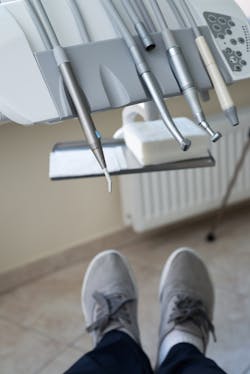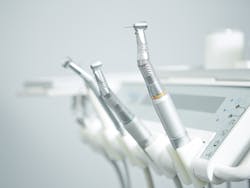A different perspective on the use of power technology for dental hygiene care in a COVID-19 environment
Considering a viral pandemic, can it ever be safe for dental hygienists to utilize power technology—such as air polishing or ultrasonics—for preventive and therapeutic care? Furthermore, what happens if we do not? These are worthy questions to consider. As of this writing, guidelines from the Centers for Disease Control and Prevention (CDC) recommend avoiding aerosol-generating procedures whenever possible.1 Many of the services provided in dentistry necessitate aerosol-generating procedures to practice at a standard of care, so where does that leave us? Those of us who are comfortable making evidence-based decisions for our patients may be struggling due to the lack of scientific data available related to dental environments and SARS-CoV-2.
Let’s remember that evidence-based dentistry is comprised of three components: (1) best available evidence, (2) patient preferences and values, and (3) clinical experience and expertise. It stands to reason that if there is a lack of data in any one of these three components, one must rely more heavily on the other two.
While some clinicians may opt not to use power technology at this time, given their personal risk factors, comfort level, or state regulations, I do not believe dental professionals should have to choose safety in lieu of power technology; rather, it is possible to apply clinical judgment to current evidence and achieve both outcomes. That said, it is my hope we will have more science soon to better understand SARS-CoV-2 as it relates to the dental environment and aerosols and spatter.
Assumptions do not equate to science
This virus appears to have the stability and viability similar to, but somewhat more significant than, another virus—SARS-CoV—in experimental conditions.2 Therefore, increased infection control considerations, preprocedural rinsing, increased use of high-volume evacuation (HVE), and increased use of personal protective equipment (PPE) should already be the new normal for dental professionals. If you were skimping on previous guidelines from the Occupational Safety and Health Administration (OSHA) and the CDC regarding infection control in your dental practice, COVID-19 should be your wake-up call to get your office in order. Thankfully, there are ample resources available from OSHA, CDC, the American Dental Association (ADA), and the American Dental Hygienists’ Association (ADHA) to guide clinicians on how to provide care once patients have been screened for COVID-19 exposure or symptoms.
Once the COVID-19 pandemic became a reality, almost immediately many organizations and state regulating agencies made recommendations to avoid using aerosol-generating devices in dentistry. Evidence is lacking confirming that the avoidance of aerosol-generating devices in dentistry reduces the possibility of viral exposures when utilizing appropriate infection control guidelines. After all, human-to-human contact is the primary mode of transmission with this virus, and a virus-carrying patient—even one who is asymptomatic—might be able to expel respiratory droplets containing SARS-CoV-2 while talking to a dental professional. It is logical that steps to reduce spatter and aerosols are warranted, but it is an assumption that the elimination of power devices makes the dental environment safer. As of this writing, evidence as to the infectious potential of SARS-CoV-2 in an airborne environment for an extended period of time is inconclusive.3
It is my opinion that power instrumentation can still be used safely. Guidelines have been established to prerinse in order to potentially lower viral load prior to treatment, use HVE to capture spatter and contaminated aerosols during the use of power technology, use disinfectants and barriers, and increase the use of PPE and face shields. When one considers that hand instrumentation may take longer than a blended approach that incorporates ultrasonics, the increased exposure time of the patient in the chair and increased exposure to saliva, blood, and/or mucous might (but it is not proven) make the risk of transmission equal. After all, HVE with an 8 mm opening has been shown to reduce more than 95% of aerobic bacterial aerosols when used with ultrasonic and air-polishing devices.4 Likewise, recommendations to use low-speed polishing opposed to air polishing with HVE are based upon assumptions that one is safer than the other—yet this is not substantiated by current evidence.
Patient preferences and clinician experiences
Completely eliminating power devices from dental hygiene care may have significant consequences. A study published in 20166 evaluated ultrasonic versus hand instrumentation and established that hand and ultrasonic instrumentation can both achieve comparable outcomes. However, ultrasonic instrumentation reduced the time by 36.6% in one referenced study and caused less trauma to the soft tissue.7 Other studies show time savings of 20%–50% for thorough periodontal debridement.8–10 Said another way, eliminating ultrasonic instrumentation could take as much as 50% longer in the COVID-19 environment.
In the absence of incorporating power technology, are your appointments lengthened to accommodate that reality? Will patients need to return to complete necessary debridement? Will pathogenic biofilm be inadequately debrided? These are legitimate questions worthy of consideration.
In addition, debridement with ultrasonic instrumentation has been shown to be more effective in limited access areas, such as furcations.10,11 This is a serious consideration given that periodontal disease affects such a large portion of our population and is associated with serious systemic conditions. It has been my experience that patients prefer power technology when used with the lowest power and water settings possible and prefer achieving the end result in less time. While not all published data concurs, several studies confirm increased patient comfort with ultrasonic versus hand instrumentation,7,12,13 which should also impact evidence-based decision-making for clinicians.
Minimizing risks of disease transmission
In the absence of hard data about how SARS-CoV-2 behaves in a dental environment, we are required to employ universal precautions. This is familiar territory for dental professionals. Let us return to the review about dental aerosols and spatter by Harrell and Molinari.4 The authors remind us of the following concept:
“No single approach or device can minimize the risk of infection to dental personnel or patients completely. A single step will reduce the risk of infection by a certain percentage, another step added to the first step will reduce the remaining risk, until such time as the risk is minimal. This can be described as a layering of protective procedures.”
Layering of protective procedures to help minimize the risk of disease transmission for dental professionals has been established, published, and is readily available to all dental professionals in this COVID-19 environment. Additional protective layers such as high-efficiency particulate (HEPA) filters, fogging devices, aerosol extraction devices, etc., may provide clinicians and patients confidence that the risk of disease transmission is being further mitigated.
Bottom line
The risk of disease transmission in a dental environment never has been and never will be zero. Universal precautions incorporated prior to COVID-19 have provided a high level of safety to patients and clinicians. Fortunately, there is minimal documentation of disease transmission in dental practices where universal precautions have been followed during the spread of other air- and blood-borne pathogens. Additional layering of infection control practices must be incorporated into dental offices in a COVID-19 environment.
After a thorough examination of available literature on this subject, it is my opinion that patients deserve our best clinical judgment before, during, and after the pandemic, which may include the use of power technology. Understandably, many individuals reading this may disagree. I hope this article will stimulate critical thinking and initiate conversation among all dental professionals. If you are reading this and are of the opinion that power technology cannot be safely incorporated at this time, or state regulations prohibit their use for dental hygiene procedures, then do not do so. As dental professionals, we are responsible for remembering that evidence-based dentistry is comprised of three components: (1) best available evidence, (2) patient preferences and values, and (3) clinical experience and expertise.
Author’s note: For additional information on this topic, register for the webinar, “Evidence-based considerations for the use of aerosol-generating devices,” at bit.ly/EBC-aerosols.
References
- Interim infection prevention and control recommendations for healthcare personnel during the coronavirus disease 2019. Centers for Disease Control and Prevention. National Center for Immunization and Respiratory Diseases (NCIRD), Division of Viral Diseases. Updated June 19, 2020. Accessed June 5, 2020. https://www.cdc.gov/coronavirus/2019-ncov/hcp/infection-control-recommendations.html
- van Doremalen N, Bushmaker T, Morris DH, et al. Aerosol and surface stability of SARS-CoV-2 as compared with SARS-CoV-1. N Engl J Med. 2020;382(16):1564-1567. doi:10.1056/NEJMc2004973
- Is the coronavirus airborne? Experts can’t agree. Nature. 2020;580(7802):175. doi:10.1038/d41586-020-00974-w
- Harrell SK, Molinari J. Aerosols and splatter in dentistry: a brief review of the literature and infection control implications. J Am Dent Assoc. 2004;135(4):429-437. doi:10.14219/jada.archive.2004.0207
- Cobb CM. Non-surgical pocket therapy: mechanical. Ann Periodontol. 1996;1(1):443-490. doi:10.1902/annals.1996.1.1.443
- Krishna R, De Stefano JA. Ultrasonic vs. hand instrumentation in periodontal therapy: clinical outcomes. Periodontol 2000. 2016;71(1):113-127. doi:10.1111/prd.12119
- Tunkel J, Heinecke A, Flemmig TF. A systematic review of efficacy of machine-driven and manual subgingival debridement in the treatment of chronic periodontitis. J Clin Periodontol. 2002;29(suppl 3):72-81. doi:10.1034/j.1600-051x.29.s3.4.x
- Checchi L, Pelliccioni GA. Hand versus ultrasonic instrumentation in the removal of endotoxins from root surfaces in vitro. J Periodontol. 1988;59(6):398-402. doi:10.1902/jop.1988.59.6.398
- Cobb CM. Clinical significance of non-surgical periodontal therapy: an evidence-based perspective of scaling and root planing. J Clin Periodontol. 2002;29(suppl 2):6-16.
- Drisko CL. Periodontal debridement: hand versus power-driven scalers. Dental Hygiene News. 1995;(8):18-23.
- Breininger DR, O’Leary TJ, Blumenshine RV. Comparative effectiveness of ultrasonic and hand scaling for the removal of subgingival plaque and calculus. J Periodontol. 1987;58(1):9-18. doi:10.1902/jop.1987.58.1.9
- Schmidlin PR, Beuchat M, Busslinger A, Lehmann B, Lutz F. Tooth substance loss resulting from mechanical, sonic and ultrasonic root instrumentation assessed by liquid scintillation. J Clin Periodontol. 2001;28(11):1058-1066.
- Wennström JL, Tomasi C, Bertelle A, Dellasega E. Full-mouth ultrasonic debridement versus quadrant scaling and root planing as an initial approach in the treatment of chronic periodontitis. J Clin Periodontol. 2005;32(8):851-859. doi:10.1111/j.1600-051X.2005.00776.x
Karen Davis, BSDH, RDH, is an independent consultant to the Hu-Friedy Group and owner of her own continuing education company, Cutting Edge Concepts. She can be reached at [email protected].
About the Author
Karen Davis, BSDH, RDH
Karen Davis, BSDH, RDH, is the founder of Cutting Edge Concepts, an international continuing education company. She practices dental hygiene in Dallas, Texas. She is an independent consultant to the Philips Corporation, Periosciences, Hu-Friedy Group, and EMS. She can be reached at [email protected].



